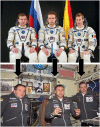Towards human exploration of space: the THESEUS review series on cardiovascular, respiratory, and renal research priorities
- PMID: 28725739
- PMCID: PMC5515532
- DOI: 10.1038/npjmgrav.2016.31
Towards human exploration of space: the THESEUS review series on cardiovascular, respiratory, and renal research priorities
Conflict of interest statement
The authors declare no conflict of interest.
Figures






References
-
- Stein, T. P Weight, muscle and bone loss during space flight: another perspective. Eur. J. Appl. Physiol. 113, 2171–2181 (2013). - PubMed
-
- Orwoll, E. S et al. Skeletal health in long-duration astronauts: nature, assessment, and management recommendations from the NASA bone summit. J. Bone Miner. Res. 28, 1243–1255 (2013). - PubMed
-
- Hargens, A. R & Richardson, S Cardiovascular adaptations, fluid shifts, and countermeasures related to space flight. Resp. Physiol. Neurobiol. 169, S30–S33 (2009). - PubMed
-
- Chouker, A. Stress Challenges and Immunity in Space: From Mechanisms to Monitoring and Preventive Strategies. (Springer, 2012).
-
- Blaber, A. P, Goswami, N, Bondar, R. L & Kassam, M. S Impairment of cerebral blood flow regulation in astronauts with orthostatic intolerance after flight. Stroke 42, 1844–1850 (2011). - PubMed
Publication types
LinkOut - more resources
Full Text Sources
Other Literature Sources

